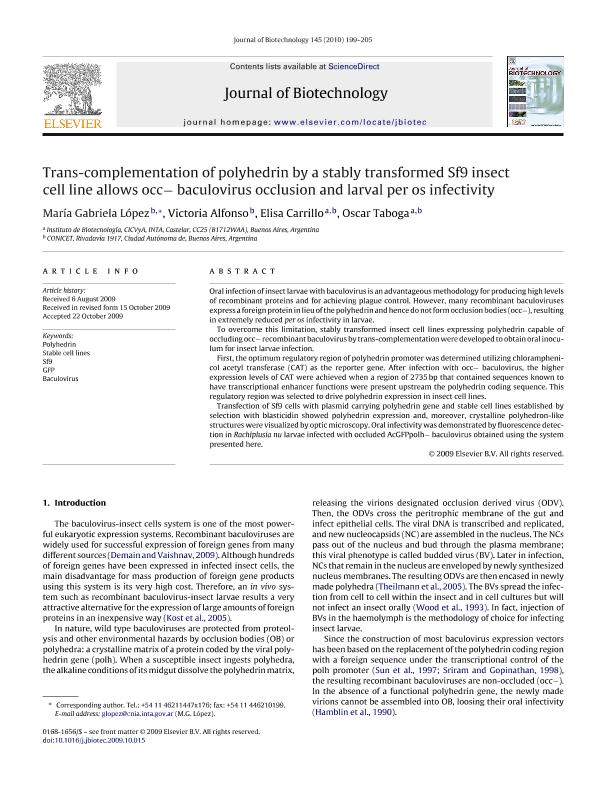Mostrar el registro sencillo del ítem
dc.contributor.author
López, María Gabriela

dc.contributor.author
Alfonso, Victoria

dc.contributor.author
Carrillo, Elisa Cristina

dc.contributor.author
Taboga, Oscar Alberto

dc.date.available
2018-07-31T19:01:43Z
dc.date.issued
2010-01
dc.identifier.citation
López, María Gabriela; Alfonso, Victoria; Carrillo, Elisa Cristina; Taboga, Oscar Alberto; Trans-complementation of polyhedrin by a stably transformed Sf9 insect cell line allows occ- baculovirus occlusion and larval per os infectivity; Elsevier Science; Journal of Biotechnology; 145; 2; 1-2010; 199-205
dc.identifier.issn
0168-1656
dc.identifier.uri
http://hdl.handle.net/11336/53645
dc.description.abstract
Oral infection of insect larvae with baculovirus is an advantageous methodology for producing high levels of recombinant proteins and for achieving plague control. However, many recombinant baculoviruses express a foreign protein in lieu of the polyhedrin and hence do not form occlusion bodies (occ-), resulting in extremely reduced per os infectivity in larvae. To overcome this limitation, stably transformed insect cell lines expressing polyhedrin capable of occluding occ- recombinant baculovirus by trans-complementation were developed to obtain oral inoculum for insect larvae infection. First, the optimum regulatory region of polyhedrin promoter was determined utilizing chloramphenicol acetyl transferase (CAT) as the reporter gene. After infection with occ- baculovirus, the higher expression levels of CAT were achieved when a region of 2735 bp that contained sequences known to have transcriptional enhancer functions were present upstream the polyhedrin coding sequence. This regulatory region was selected to drive polyhedrin expression in insect cell lines. Transfection of Sf9 cells with plasmid carrying polyhedrin gene and stable cell lines established by selection with blasticidin showed polyhedrin expression and, moreover, crystalline polyhedron-like structures were visualized by optic microscopy. Oral infectivity was demonstrated by fluorescence detection in Rachiplusia nu larvae infected with occluded AcGFPpolh- baculovirus obtained using the system presented here. © 2009 Elsevier B.V. All rights reserved.
dc.format
application/pdf
dc.language.iso
eng
dc.publisher
Elsevier Science

dc.rights
info:eu-repo/semantics/openAccess
dc.rights.uri
https://creativecommons.org/licenses/by-nc-sa/2.5/ar/
dc.subject
Baculovirus
dc.subject
Gfp
dc.subject
Polyhedrin
dc.subject
Sf9
dc.subject
Stable Cell Lines
dc.subject.classification
Otras Ciencias Biológicas

dc.subject.classification
Ciencias Biológicas

dc.subject.classification
CIENCIAS NATURALES Y EXACTAS

dc.title
Trans-complementation of polyhedrin by a stably transformed Sf9 insect cell line allows occ- baculovirus occlusion and larval per os infectivity
dc.type
info:eu-repo/semantics/article
dc.type
info:ar-repo/semantics/artículo
dc.type
info:eu-repo/semantics/publishedVersion
dc.date.updated
2018-07-30T17:59:35Z
dc.journal.volume
145
dc.journal.number
2
dc.journal.pagination
199-205
dc.journal.pais
Países Bajos

dc.journal.ciudad
Amsterdam
dc.description.fil
Fil: López, María Gabriela. Consejo Nacional de Investigaciones Científicas y Técnicas; Argentina
dc.description.fil
Fil: Alfonso, Victoria. Consejo Nacional de Investigaciones Científicas y Técnicas; Argentina
dc.description.fil
Fil: Carrillo, Elisa Cristina. Consejo Nacional de Investigaciones Científicas y Técnicas; Argentina. Instituto Nacional de Tecnología Agropecuaria. Centro de Investigación en Ciencias Veterinarias y Agronómicas; Argentina
dc.description.fil
Fil: Taboga, Oscar Alberto. Consejo Nacional de Investigaciones Científicas y Técnicas; Argentina. Instituto Nacional de Tecnología Agropecuaria. Centro de Investigación en Ciencias Veterinarias y Agronómicas; Argentina
dc.journal.title
Journal of Biotechnology

dc.relation.alternativeid
info:eu-repo/semantics/altIdentifier/doi/https://dx.doi.org/10.1016/j.jbiotec.2009.10.015
dc.relation.alternativeid
info:eu-repo/semantics/altIdentifier/url/https://www.sciencedirect.com/science/article/pii/S0168165609004842
Archivos asociados
